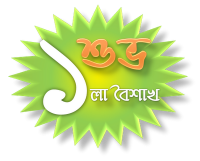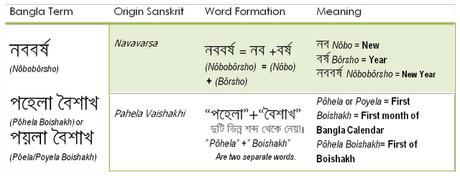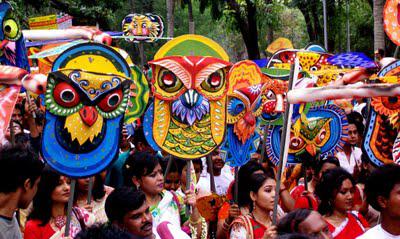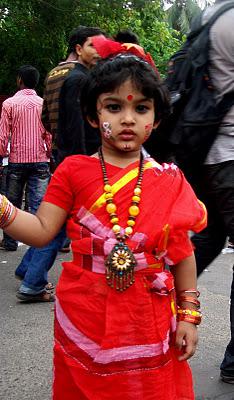 Bangla New Year[Bangla: বাংলা নববর্ষ Bangla Nôbobôrsho] orPohela/Poyela Boishakh[পহেলা বৈশাখPôhela Boishakhor পয়লা বৈশাখPôhela Boishakh] marks the first day of the Bangla Calendar. Poyela Boishakh is celebrated with great fervor in the South Asian region of Bengal (Bangladesh and Indian/West Bengal) and among Bengali communities living in the Indian states of Tripura and Assam (specially in Barak Valley [Bangla:বরাক উপত্যকা]). Poyela Boishakh coincides with the New Years in many otherSouthern Asiancalendars.
Bangla New Year[Bangla: বাংলা নববর্ষ Bangla Nôbobôrsho] orPohela/Poyela Boishakh[পহেলা বৈশাখPôhela Boishakhor পয়লা বৈশাখPôhela Boishakh] marks the first day of the Bangla Calendar. Poyela Boishakh is celebrated with great fervor in the South Asian region of Bengal (Bangladesh and Indian/West Bengal) and among Bengali communities living in the Indian states of Tripura and Assam (specially in Barak Valley [Bangla:বরাক উপত্যকা]). Poyela Boishakh coincides with the New Years in many otherSouthern Asiancalendars. Bangla New Year or Pohela Boishakh connects all Ethnic Bengalis irrespective of religious and regional differences. Ethnic Bengalis across the world and from all walks of life unite to celebrate the Public or Universal Festival of Bengalis i.e. Pohela Boishakh; it’s the occasion to welcome the New-Year with a new hope of peace, prosperity and goodwill. Poyela Boishakh generally falls on 14th or 15th of April of the Georgian calendar. InBangladesh, it is a national holiday celebrated around 14th April according to the official amended calendar designed by theBangla Academy. In India, inIndian/West Bengal& Assamit is a public (state) holiday and is publicly celebrated on 15th of April
Bangla New Year or Pohela Boishakh connects all Ethnic Bengalis irrespective of religious and regional differences. Ethnic Bengalis across the world and from all walks of life unite to celebrate the Public or Universal Festival of Bengalis i.e. Pohela Boishakh; it’s the occasion to welcome the New-Year with a new hope of peace, prosperity and goodwill. Poyela Boishakh generally falls on 14th or 15th of April of the Georgian calendar. InBangladesh, it is a national holiday celebrated around 14th April according to the official amended calendar designed by theBangla Academy. In India, inIndian/West Bengal& Assamit is a public (state) holiday and is publicly celebrated on 15th of AprilHistory of Pohela Boishakh | পহেলা বৈশাখের ইতিহাস
- Pohela Boishakh celebration dates back to Mughal Emperor Jalaluddin Muhammad Akbar’s [জালাল উদ্দিন মোহাম্মদ আকবর]reign. Akbar the Great, the renowned grandson of Zahiruddin Muhammad Babar [জহিরুদ্দিন মুহম্মদ বাবর] was the 3rd Mughal Emperor. In order to ease tax collection, Akbar-e-Azamchanged the tradition of agricultural tax collection according to Hijri calendar [হিজরী সন] and ordered a reform of the calendar because the Hijri calendar, being a lunar calendar- did not coincide with the harvest sessions and thus the farmers faced severe difficulties in paying taxes out of season.
- The Royal Astrologer of Emperor Akbar's court, Aamir Fatehullah Siraji [আমির ফাতেউল্লাহ সিরাজী], was the one who actually devised this calendar, after performing a research on the lunar Hijri and Solar calendar[সৌর সন]. The unique characteristic of the Bengali year was that, rather than being a lunar calendar, it was based on an amalgamation of the solar and lunar year. This was indeed a great development, as the solar and lunar years were formulated in very different methods.
- Initially this calendar was named as “Fasli San” [ফসলি সন] (agricultural year) and then Bônggabdo [বঙ্গাব্দ] or Bangla Year was introduced on 10/11 March 1584, but was dated from 5th November 1556 or 963 Hijri. This was the day that Akbar defeated Himu in the second Battle of Panipat to ascend the throne. This not only glorified his victory but also streamlined revenue collection into an orderly process.
- It was Akbar-e-Azam’s directive to settle all dues on the last day of Choitro. The next day was the first day of the New Year (Poyela Boishakh), the day for a new beginning; landlords would distribute sweets among their tenants, and Businessmen would open a “HalKhata” [হালখাতা](new accounts book) and close their old ones. Businessmen used to invite their customers to share sweets and renew their business relationship with them. There were fairs and festivities allover and gradually Poyela Boishakh became a day of celebration.
Celebration of Pohela Boishakh | পহেলা বৈশাখ উজ্জাপনPohela Boishakh is a Public festival [সার্বজনীন উৎসব] of the Bengalis; it is celebrated among all Bengalis- irrespective of religious and regional differences. As discussed earlier; the celebrations started from Akbar’s reign. But the Public celebration of Poyela Boishakh and the large-scale organizations of cultural events have started more recently.

Celebration of Pohela Boishakh, Dhaka [My Sincere Thanks to S.M. Tanvir Ayon for this Magnificent Snapshot. ]
Rabindranath Tagore had said,'প্রতিদিন মানুষ ক্ষুদ্র, দীন, একাকী কিন্তু উৎসবের দিনে মানুষ বৃহৎ, সে সমস্ত মানুষের সঙ্গে একত্র হইয়া বৃহৎ, সেদিন সমস্ত মনুষ্যত্বের শক্তি অনুভব করিয়া মহৎ।'[“Prōtidin mānush khudrō, deen, ekāki. Kintu Utsōber dine mānush brihōt, se sōmōstō mānusher sōnge āekōtrō hōiyā brihōt, sedin sōmōstō mōnushōtver shōkti ōnubhōv kōriyā mōhōt”].The summary of the statement is that, a person feels stronger, complete & united when he’s among other fellow mates on the occasion of a festival as compared to daily life. Truly, socializing brings a lot of change in the personality of a person; it actually changes his outlook towards the world and makes him broad minded, well-mannered and a better person indeed. Nowadays it’s seen that, due to our busy schedule and hectic life we tend to forget the purpose of the festivals after they are over; people come together during festivals, forget their differences but as soon as the festival is over the differences are highlighted once again!The Poyela Boishakh celebrations and festivities reflect the life in rural Bengal. Usually on this day everything is washed and cleaned; people bathe early in the morning and dress in fine clothes and then go to visit relatives and friends. Special food items are prepared for the guests. Starting as a rural festival, Poyela Boishakh has now become an integral part of Bengali culture.
People from all walks of life dress-up in traditional Bengali attire: Men wear dhuti / payejama / lungi and kurta /Panjabi. Young women wear white saris with red borders, and adorn themselves with tip (bindis), churi (bangles) and fūl (flowers). Its like a custom to start the day with the traditional breakfast of Pantā-Bhāt (leftover rice soaked in water), onion, Shōbuj Lōnkā (green chillies), Āchār (pickles), dāl (lentils) & Bhāja Elish Māch (fried Hilsa fish).
Boishakhi Fairs are organized in many parts of Bengal. The lifestyle of rural Bengal is showcased in almost all these fairs. Various traditional handicrafts, toys, cosmetics, agricultural products, as well as various kinds of food and sweets are sold at these fairs. The fairs also provide entertainment, with singers and dancers staging jatra (traditional plays), pala gan, kobigan, jarigan, gambhira gan, gazir gan and alkap gan. They present folk songs as well as baul, marfati, murshidi and bhatiali songs. Narrative plays like Laila-Majnu, Yusuf-Zulekha and Radha-Krishna are staged. Among other attractions of these fairs are puppet shows, merry-go-round and Giant wheels are also installed and are enjoyed by the children.
Historical Importance of Poyela Boishakh in Bangladesh | বাংলাদেশে পহেলা বৈশাখের ঐতিহাসিক গুরুত্ব
In an attempt to suppress Bengali culture, the Pakistani Government had banned poems written by Rabindranath Tagore, the most famous poet and writer in Bengali literature. Protesting this move, Chhayanat opened their Poyela Boishakh celebrations at Ramna Park with Tagore's song welcoming the month in 1965. The day continued to be celebrated in East Pakistan (now Bangladesh) as a symbol of Bengali culture. After 1972 it became a national festival, a symbol of the Bangladesh nationalist movement and an integral part of the people's cultural heritage.Later, in the mid- 1980s the Institute of Fine Arts added color to the day by initiating the Boishakhi parade, which is much like a carnival parade. In the big metropolitans like Dhaka and Chittagong this day is marked by mass crowd flocking to hundreds of open air concerts and cultural programs, mask rallies etc.
DHAKA, Bangladesh | ঢাকা, বাংলাদেশ
In Dhaka, large numbers of people pour out of their houses and gather early in the morning under the banyan tree at Ramna Park [রমনা বটমুল]. Along with the rising sun, the Chhayanat [ছায়ানট] artists sing the famous song of Tagore in chorus, “এসো, হে বৈশাখ, এসো এসো”Esho, he Boishakh, Esho Esho (Come, O Boishakh, Come, Come), welcoming Boishakh.
Colorful Processions on Pohela Boishakh, Dhaka
[My Sincere Thanks to S.M. Tanvir Ayon for this Image]

Dhakar Rastay Nemeche Sundor Pori!
[Image Click by: S.M. Tanvir Ayon]
Many old festivals connected with New Year's Day have disappeared, while new festivals have been added. With the abolition of the zamindari system, the punya connected with the closing of land revenue accounts has disappeared. Kite flying in Dhaka and bull racing in Munshiganj used to be very colourful events. Other popular village games and sports were horse races, bullfights, cockfights, flying pigeons, and boat racing. Some festivals, however, continue to be observed; for example, bali (wrestling) in Chittagong and gambhira in Rajshahi are still popular events.Pohela Boishakh celebration has also hit the dancefloor of the pubs and clubs in the major cities, as an increasing number of parties are being organized nowadays for the youth. Thus, giving the celebration a western touch but keeping the indigenous feel intact.
CHOTTOGRAM, Bangladesh | চট্টগ্রাম, বাংলাদেশ
The centre of attraction of the Poyela Boishakh celebrations in the port city Chottogram is the DC Hill Park [ডিসি পাহাড় পার্ক]. Sammilitō Sanskritik Jot [সম্মিলিতসাংস্কৃতিক জোটে] organizes a two day festival to bid farewell to the old year and welcome the New Year. Various cultural events are organized here including plays etc. Public celebration of Poyela Boishakh in Chottogram was started in 1973; the initiative was taken by the politicians to promote Bengali culture.- Chottogram Hill Tracts | চট্টগ্রামের পার্বত্য জেলা : In the Hill tracts of Chottogram three different ethnic minority groups have their individual New Year celebrations.Boisuk [বৈশুখ] ofTripura People, Sangrai [সাংগ্রাই] ofMarma peopleand Biju [বিজু] ofChakma people; presently they have come together to celebrate it commonly as Boi-Sa-Bi [বৈ-সা-বি], a day of a wide variety of festivities; specially need to mention the water festival[জল উৎসব] of the Marma people.
Kolkata and West Bengal | কলকাতাএবং পশ্চিম বঙ্গKolkata, the sovereign of Bengalis in India; witnesses some of the grand celebrations of Poyela Boishakh. In Kolkata and rest of Indian/West Bengal, Poyela Boishakh and indeed the entire month of Boishakh is considered auspicious time for marriages, opening of new business ventures etc. Choitro is the Last month of the Bangla year; the garment traders give special discounts throughout the month. The last day of Choitro, is celebrated as Choitro Sankranti among the Hindu community, and Charak Pujo is held on this day. On this very same day Charak Mela/fair is organized in various parts of rural Bengal;some really miraculous acrobatics are performed by the members and these stunts are quite risky indeed.The day of Poyela Boishakh is a day of cultural events. Like Bangladesh, here also people wake up & bathe early in the morning and dress up in traditional Bengali attire. Many go for Probhat Pheri (a parade similar to “Shobhajatra” in Bangladesh, but it’s not as colorful as that) to welcome the first day of the New Year singing Rabindra Sangeet, here also the song “এসো, হে বৈশাখ, এসো এসো”Esho, he Boishakh, Esho Esho is very popular.Pohela Boishakh is also the occasion when the whole family comes for a get together; youngsters touch feet of elders seeking benediction(আশীর্বাদ), and peers greet each other Suvo Nôbobôrsho with a hug (Kolakuli কলাকুলি). The celebration remains incomplete without “mishit mukh” exchanging sweets with the near and dear ones.Businessmen open new accounting books (HalKhata) on this day; for the Bengali Hindu businessmen HalKhata begins only after performing puja, “Swastik” sign is drawn on the HalKhata by the priests. Devotees are seen in front of the Kalighat temple (কালীঘাট মন্দির), in long queues, from late night. Devotees offer Puja to receive the blessings of the almighty.The Government of West Bengal organizes various fairs and cultural events in different parts of the state. The most famous of these is Bangla Sangit Mela, held at Nandan-Rabindra Sadan ground.


posted on 08 November at 15:15
in u.k at Teesside Uneversity as part of my english language presentation I am going to present pahela boishakh.pray fr me.